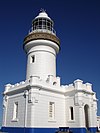Fort Denison Light: Difference between revisions
m Removed Category:Buildings and structures in Sydney (using HotCat) |
m Removed Category:Lighthouses in Australia; Adding category Category:Lighthouses in Sydney (using HotCat) |
||
| Line 71: | Line 71: | ||
{{Lighthouses of New South Wales}} |
{{Lighthouses of New South Wales}} |
||
| ⚫ | |||
[[Category:1913 architecture]] |
[[Category:1913 architecture]] |
||
| ⚫ | |||
Revision as of 19:47, 16 October 2010
 Fort Denison Light, 2006 | |
 | |
| Standort | Fort Denison, New South Wales, Australia |
|---|---|
| Coordinates | 33°51′17″S 151°13′34″E / 33.8546°S 151.226°E |
| Tower | |
| Constructed | 1913 |
| Foundation | Martello Tower |
| Height | 20 feet (6.1 m)[1] |
| Shape | round, lantern, gallery |
| Markings | white, black lantern |
| Fog signal | Bell, continuous[2] |
| Light | |
| Focal height | 61 feet (19 m) |
| Range | 5 nautical miles (9.3 km; 5.8 mi) |
| Characteristic | four white flashes, separated by 2s, every 15s |
Fort Denison Light, also known as Pinchgut Light, is an active lighthouse located on top of a Martello Tower at Fort Denison, a former penal site and defensive facility occupying a small island in Sydney Harbour, New South Wales, Australia. The island is located downstream from the Harbour Bridge near Potts Point and the Royal Botanic Gardens. The fort is also known as "Pinchgut" lending its name to the light.
History
The lantern and light, built in Birmingham, England, were added on top of the Martello Tower in 1913, replacing an 8 inches (20 cm) gun. The original light source was an acetylene gas carbide lamp, and it was converted to electricity by 1926. The station also includes a tide gauge, established in the mid 1800s, navigation channel markers, and a fog bell.
Renovation
On October 30, 2003 the entire lightroom structure was removed for renovation. As the National Parks and Wildlife Service curator Stephen Thompson said an airlift was the safest way, the lantern was transported to shore by a helicopter in a sling. Renovation took place at a workshop in the nearby St Peters. The entire operation was coordinated by National Parks, the Sydney Ports corporation and Australian Defence Industries.
For the renovation the structure was disassembled, paint was removed and new steel patches were welded onto corroded areas. A replica base ring was fabricated and hot riveted into place. The surface was then painted and treated against corrosion.
On May 20, 2004 the lantern was returned by helicopter and reinstalled.
Site operation
The light is managed by the Sydney Ports corporation. The site is managed by the National Parks and Wildlife Service in the Department of Environment, Climate Change and Water since 1992, as part of the Sydney Harbour National Park.
Visiting
The island is accessible by boat. It is open for guided tours for a fee, requiring reservation. The tower is closed to the public.
See also
References and notes
- List of Lights, Pub. 111: The West Coasts of North and South America (Excluding Continental U.S.A. and Hawaii), Australia, Tasmania, New Zealand, and the Islands of the North and South Pacific Oceans (PDF). List of Lights. United States National Geospatial-Intelligence Agency. 2009. p. 127.
- Rowlett, Russ. "Lighthouses of Australia: Northern New South Wales". The Lighthouse Directory. University of North Carolina at Chapel Hill. Retrieved 2010-08-29.
- Searle, Garry. "Fort Denison". Lighthouses of New South Wales. SeaSide Lights.
- "Sydney's Fort Denison Light Restored". Lighthouse Digest. The Lighthouse Depot. 2004. Retrieved 31 August 2010.
{{cite journal}}: Unknown parameter|month=ignored (help) - "Australia Today – Fort Denison (Pinchgut): A Relic of Early Sydney (1939)". Australia's audio and visual heritage online. National Film & Sound Archive. Retrieved 31 August 2010.
External links
- "List of Lighthouses of New South Wales". Lighthouses of Australia. Lighthouses of Australia Inc.

